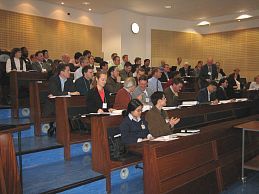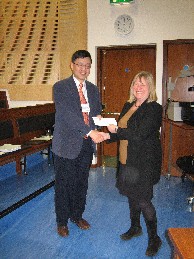
Fouling, Cleaning & Disinfection in Food Processing 2006
This was the latest in the series of meetings on this topic which started in Lund, Sweden, in 1981. The growth of interest in, and importance of, the topic was reflected in the number and diversity of delegates, with over 80 delegates attending the meeting, from as far as New Zealand, Australia and the USA. The bulk of the delegates were from Europe and a quarter were research students (including a sizeable number of UK-based PhD students whose registration fees were covered by the UK Engineering and Physical Sciences Research Council, EPSRC).
The conference proceedings - which are available for purchase (£40 including post & packaging) - number over 50 papers and these were organised into four themes, namely Surfaces, Measurement and Modelling, Dairy and Microbes. The first two themes were covered on the first day and marked how the technology available to study surface deposition, cleaning and disinfection have advanced. The Surfaces theme included papers on modification of surface free energy, nano-structure, catalytic activity and microbial attachment. The Monday sessions featured studies using atomic force microscopy, MRI, confocal laser scanning microscopy and fluid dynamic gauging, and modelling across the length scales.
The second day was dedicated to papers with a focus on diary processing and the papers covered fouling, cleaning and operation of hard surfaces and membrane operations. The day began with a review of progress in the area from Dr Peter de Jong from NIZO Food Research (NL) and the sessions demonstrated that good progress continues to be made, particularly in meeting the challenges of modern dairy operation, where multi-product lines are commonplace and optimising operation is a key deliverable. The subjects covered ranged from fundamental aspects, such as understanding protein dissolution, to improvement of industrial operation, e.g. the minimisation of sodium hydroxide use in Australia to reduce the environmental impact of cleaning.
The third day featured microbial attachment and removal, and included papers on biofilm growth and detachment, inactivation and sterilisation. Novel disinfection approaches were presented, including the use of naturally disinfecting biopolymers derived from spaghnum moss and cold gas plasmas (which have found use in surgical applications).
 Feedback from delegates indicated that this was a very successful meeting, and there is strong interest in another conference in 2010. The format featured normal oral presentations and poster presentations accompanied by short (5 minute) summaries, so that participation was high and parallel sessions were not required. The success of the meeting lay in the willingness of delegates to cross disciplinary and cultural boundaries. The settings of Jesus College, Emmanuel College and the Department of Chemical Engineering helped. The UK Department of the Environment, Food and Rural Affairs (DEFRA) provided ten prizes for papers which the Technical Committee considered to novel, interesting and/or applicable. These were awarded to Paul Airey (Manchester Metropolitan University), Wolfgang Augustin (Technical University of Braunschweig), Grace Christian (Chipping Campden FRA/University of Birmingham), Michael Kong (University of Loughborough), Ruben Mercade-Prieto (University of Cambridge), Ashok Parbhu (IRL, NZ), Ana Pereira (University of Porto), Manuel Simoes (University of Minho), Michael Weeks (Food Science Australia), and Kath Whitehead (Manchester Metropolitan University).
Feedback from delegates indicated that this was a very successful meeting, and there is strong interest in another conference in 2010. The format featured normal oral presentations and poster presentations accompanied by short (5 minute) summaries, so that participation was high and parallel sessions were not required. The success of the meeting lay in the willingness of delegates to cross disciplinary and cultural boundaries. The settings of Jesus College, Emmanuel College and the Department of Chemical Engineering helped. The UK Department of the Environment, Food and Rural Affairs (DEFRA) provided ten prizes for papers which the Technical Committee considered to novel, interesting and/or applicable. These were awarded to Paul Airey (Manchester Metropolitan University), Wolfgang Augustin (Technical University of Braunschweig), Grace Christian (Chipping Campden FRA/University of Birmingham), Michael Kong (University of Loughborough), Ruben Mercade-Prieto (University of Cambridge), Ashok Parbhu (IRL, NZ), Ana Pereira (University of Porto), Manuel Simoes (University of Minho), Michael Weeks (Food Science Australia), and Kath Whitehead (Manchester Metropolitan University).

